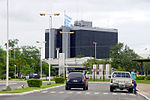Formosa, Argentina
Formosa | |
|---|---|
 | |
| Country | Argentina |
| Province | Formosa |
| Department | Formosa |
| Area | |
| • Total | 6,195 km2 (2,392 sq mi) |
| Population | |
| • Total | 209,787 |
| • Density | 34/km2 (88/sq mi) |
| Demonym | formoseño |
| Time zone | UTC-3 (ART) |
| CPA base | P3600 |
| Dialing code | +54 3717 |
Formosa is the capital city of the Argentine province of Formosa, on the banks of the Paraguay River, about 1,200 km (746 mi) from Buenos Aires, on National Route 11. It has a population of about 210,000 as per the 2001 census [INDEC].
Formosa is the hub of the provincial industry, that processes the product of its natural resources. The port that serves the Paraguay towards the Paraná River is the main transport means for the provincial production.
Notable sights of the city include the Nuestra Seńora del Carmen Cathedral, the Government House, the Torelli Botanic Forest Garden, the Provincial History Museum (Museo Histórico Provincial), the Estadio Centenario ("Centenary Stadium") football stadium, the Guaicole fauna reserve, the shore of the Paraguay River, the Isla de Oro Island, and the Central Square named after José de San Martín.
The local climate is humid sub-tropical, with average temperatures of 28 °C in summer and 16 °C in winter.
The El Pucú Airport (IATA: FMA, ICAO: SARF), at 26°12′04″S 58°13′09″W / 26.20111°S 58.21917°W, 7 kilometres south of the city, serves charter flights, and regular flights to Buenos Aires.
History

The lands were initially inhabited by Toba and Wichí (Mataco) aboriginals. On April 8, 1879 Commander Luis Jorge Fontana founded the settlement that would become the capital of the National Territory of Chaco from 1884 to June 15, 1955, when it gained the status of province. The Formosa campus of the National University of the Northeast was established as the National University of Formosa in 1988.
The name of the city (and the province) comes from the archaic Spanish word fermosa (currently hermosa) meaning "beautiful". The name Vuelta Fermosa or Vuelta la Formosa was used by Spanish sailors in the 16th century to describe the area where the Paraguay River makes a turn, right in front of the actual city. These sailors were searching for the legendary Sierra del Plata.[1] Coincidentally, the province is partially antipodal to Taiwan (formerly called Formosa).
Formosa is mentioned in the novel Travels with My Aunt, by Graham Greene.
Culture
The city, which is only a few hundred meters away from Paraguay across the river, has a culture closer to that of Paraguay than the "porteño" culture of Buenos Aires. Laid back and relaxed, its young people relax on the Costanera, the recently restored pathway along the Río Paraguay which serves as a venue for arts displays and features a fast-food restaurant, or at boliches, local clubs. The city's well-known cultural institutions include the Formosa Regional Historical Museum (image, above), the Juan Pablo Duffard Historical Museum (a National Historic Monument), the Qomp Toba Artisanal Museum, and the Oscar Albertazzi Arts Institute.
The city has, since the 1970s, enjoyed increasing domestic tourism as a winter destination and, since the devaluation of the peso in 2002, growing international tourism, as well. Formosa is currently home to one five-star hotel (the International Tourist Hotel) and four four-star hotels. One other five-star establishment, the Neo Formosa, is now under construction and will feature a casino and shopping gallery.
-
The former railway station, today city hall
-
Provincial Government building
-
Cathedral of Our Lady of Carmen
-
Riverwalk
Festivals
Formosa celebrates the Fiesta de la Virgen de la Catedral on July 16 in honor of its patron saint. Celebrations, which occur in the main Plaza San Martín, include the traditional pericón dance and stalls selling everything from food to balloons.
It also celebrates the Fiesta del Río in November, Carnaval on weekends in February and Día de la Fundación de Formosa in April.
Climate
The city has a climate considered as "Humid Subtropical" or "Cfa" by Köppen classification. Winters are generally mild, air frosts are very uncommon . Summers are hot and humid. During the most extreme heat waves, temperatures exceed 40°C (104°F). Temperatures have exceeded 35°C (95°F) in every season.[2]
Rainfall can be expected throughout the year though summer is usually the wettest season. Thunderstorms can be intense with frequent lightning, powerful gusts of wind and intense precipitation.
| Climate data for Formosa, Argentina | |||||||||||||
|---|---|---|---|---|---|---|---|---|---|---|---|---|---|
| Month | Jan | Feb | Mar | Apr | May | Jun | Jul | Aug | Sep | Oct | Nov | Dec | Year |
| Mean daily maximum °C (°F) | 33.5 (92.3) |
32.8 (91.0) |
31.9 (89.4) |
27.3 (81.1) |
24.3 (75.7) |
21.5 (70.7) |
21.9 (71.4) |
24.2 (75.6) |
25.2 (77.4) |
28.8 (83.8) |
30.8 (87.4) |
32.6 (90.7) |
27.9 (82.2) |
| Mean daily minimum °C (°F) | 22.4 (72.3) |
21.9 (71.4) |
20.6 (69.1) |
18.5 (65.3) |
15.2 (59.4) |
12.1 (53.8) |
12.1 (53.8) |
13.4 (56.1) |
14.2 (57.6) |
17.5 (63.5) |
19.9 (67.8) |
21.1 (70.0) |
17.4 (63.3) |
| Average precipitation mm (inches) | 156.2 (6.15) |
120.6 (4.75) |
151.7 (5.97) |
212.5 (8.37) |
115.3 (4.54) |
75.7 (2.98) |
55.5 (2.19) |
61.8 (2.43) |
102.2 (4.02) |
108.4 (4.27) |
202.3 (7.96) |
136.2 (5.36) |
1,498.4 (58.99) |
| Source: Servicio Meteorológico Nacional (Argentine Meteorological Service) (NB: Data from the period 1981-1990)[2] | |||||||||||||
References
- ^ Reseña (Spanish)
- ^ a b "Guía Climática para el Turismo (Climate Guide for Tourists)" (in Spanish). Retrieved March 8, 2008.
External links
- Official website (Spanish)
- Municipal information: Municipal Affairs Federal Institute (IFAM), Municipal Affairs Secretariat, Ministry of Interior, Argentina. (in Spanish)
- National University of Formosa (Spanish)




